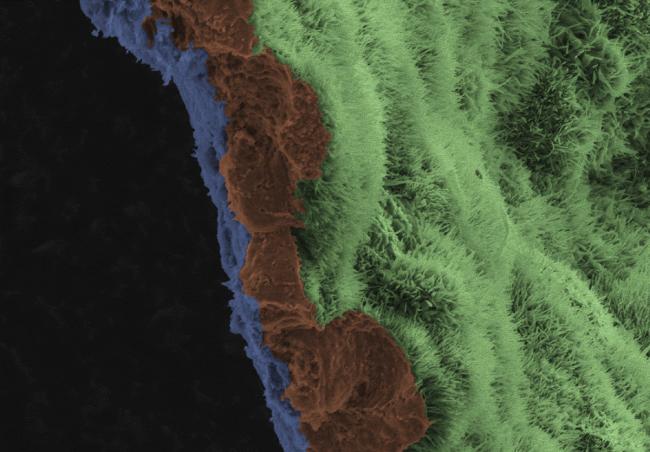Patch replaces damaged retinal cells
January 29, 2019
Patch replaces damaged retinal cells
At a Glance
- Researchers developed a biodegradable patch for replacing diseased cells in the eye with healthy ones.
- The findings provide the basis for preliminary safety tests of the method in people.

Macular degeneration is a leading cause of vision loss among people over 50. This disease damages an area near the center of the retina, the light-sensitive tissue in the eye. Retinal pigment epithelial (RPE) cells gradually waste away and die. These pigmented cells support and nurture light-sensing cells known as photoreceptors, so these cells also eventually die. The disease makes the center of your vision blurry, distorted, or dark.
Researchers have tried to treat macular degeneration by replacing dying RPE cells with healthy ones derived from stem cells. But the new cells have a hard time growing without supportive structures. If the cells are from another person, the patient’s immune system might reject the new cells. Another potential problem is that previous techniques used cells that were prone to having cancer-causing genomic alterations.
A team led by Dr. Kapil Bharti at NIH’s National Eye Institute (NEI) set out to develop a treatment for macular degeneration that used RPE cells derived from a patient’s own healthy cells. They also designed a scaffold to support healthy RPE cells and promote their attachment inside the eye. The work was also funded by the NIH Common Fund. Results were reported in Science Translational Medicine on January 16, 2019.
The research team collected cells from blood that was donated by three people with macular degeneration and converted them into induced pluripotent stem cells (iPSCs). These cells can theoretically be coaxed into becoming any other cell type. Next, the team programmed the iPSCs to become RPE cells. The cells were grown in a single layer on a biodegradable polymer scaffold. The researchers designed a tool that enabled them to slip the patch between damaged retinal pigment cells and photoreceptors in the eyes of rats and pigs.
Ten weeks after the patches were inserted, imaging studies showed integration into the animal retinas. Lab tests confirmed that the transplanted cells expressed the gene for RPE65, a mark of mature RPE cells. Further tests showed that the transplanted RPE cells were helping keep photoreceptors healthy. In contrast, photoreceptors died in a test of a patch without RPE cells.
Because a patient would receive RPE cells derived from their own cells, the chance that the immune system would reject them is low. In addition, the research team didn’t detect any known cancer-causing alterations in the iPSC-derived RPE cells.
The researchers are now planning to test the safety of this treatment in people.
Related Links
- Regenerating Retinal Cells in Mice
- Long-Term Benefits of Age-Related Macular Degeneration Treatments
- Drugs Equally Effective for Age-Related Vision Loss
- Retinal Device Restores Sight in Mice
- Age-Related Macular Degeneration (AMD)
- Your Aging Eyes
- Keep Your Vision Healthy
References
Clinical-grade stem cell-derived retinal pigment epithelium patch rescues retinal degeneration in rodents and pigs. Sharma R, Khristov V, Rising A, Jha BS, Dejene R, Hotaling N, Li Y, Stoddard J, Stankewicz C, Wan Q, Zhang C, Campos MM, Miyagishima KJ, McGaughey D, Villasmil R, Mattapallil M, Stanzel B, Qian H, Wong W, Chase L, Charles S, McGill T, Miller S, Maminishkis A, Amaral J, Bharti K. Sci Transl Med. 2019 Jan 16;11(475). pii: eaat5580. doi: 10.1126/scitranslmed.aat5580. PMID: 30651323.
Funding
NIH’s National Eye Institute (NEI) and Common Fund.


